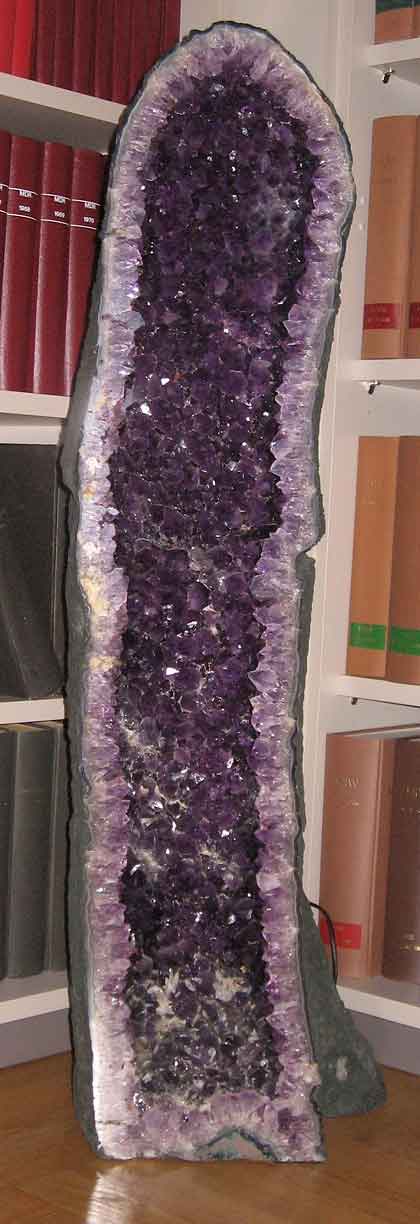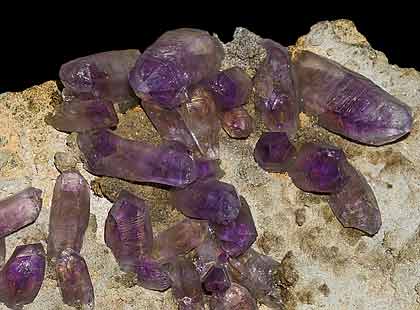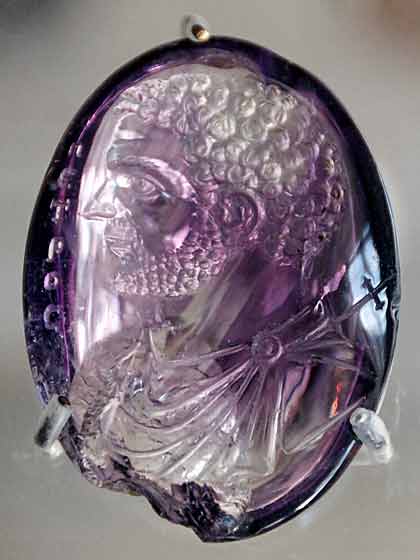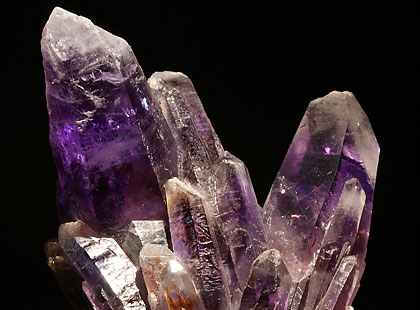Birthstones by the Month
The February Birthstone is Amethyst
Amethyst Facts
The February birthstone is Amethyst. Amethyst is a purple variety of the well known Quarts crystal and is a semiprecious gemstone. It is known to be the traditional birthstone for February.
The hardness of Amethyst is the same as Quartz (Moh’s scale 7) and it suitable for many types of jewelry and carved artworks. Decorative geodes can be found at many natural gemstone shops starting with small bookends and going all the up in size to huge monolithic decorative pieces.

Amethyst Geode
This is an extremely large amethyst geode formation. Geodes of this size are less common. [2]
The characteristics of Amethyst
Amethyst occurs naturally in the primary colors of a light pink-purple to a deep purple. Amethyst may have blue and red secondary colors.
Very nice specimens of Amethysts can be found in Sri Lanka, Siberia, the Far East and Brazil.
The best grade is called "Deep Siberian" and has about 75% purple and about 25% blue and (depending on the light source) secondary red hues.
Green quartz is sometimes incorrectly called green amethyst. The proper term for other types of green quartz are Prasiolite, Vermarine or Lime Citrine.
Cut and Clarity for the February birthstone
The color of amethyst can vary in intensity and is often laid out in stripes parallel to the final faces of the crystal. The art of lapidary work on Amethyst involves cutting the stone optimally to place the color in a way that makes the color of the finished gem uniform.
Because the layers of striped color and be very thin it can be very difficult to properly cut the February birthstone to be a homogeneous looking stone.
The value of Amethyst
Up until the 18th century, amethyst was integral to the cardinal, or most valuable, gemstones (along with diamond, sapphire, ruby, and emerald).
Unfortunately, because of the widespread deposits in sites such as Brazil, it has lost most of its value because of the lack of scarcity.
Color is the biggest factor in the value. Depth of color, possibly with red flashes if cut is desirable and has an effect on the value.
Amethyst’s gemstone value is not primarily defined by carat weight. This is unlike most gemstones where when the carat weight increases the value of the stone increases dramatically.
The highest grade of Amethyst ("Deep Russian") is extraordinarily rare, when one is found, its value is determined by the demand of collectors.

Amethyst crystals
Another example of the February birthstone in the rough displaying a sparse crystal arrangement. [3]
Is Amethyst ever treated?
Natural amethyst can be dichroic in reddish violet and bluish violet.
When heat treaded it turns yellow-orange to dark brownish and may resemble Citrine. This treatment process causes Amethyst to lose its dichroism, unlike genuine Citrine. When partially heated, amethyst can result in ametrine.
Amethyst can fade if overexposed extreme light sources. It can also be artificially darkened with adequate irradiation.

Amethyst Cameo
Portrait of Roman Emperor Caracalla; inscription in Greek letters and cross added at the Byzantine period in order to transform the portrait in that of St. Peter. Amethyst intaglio, ca. 212 CE. From the treasury of the Sainte-Chapelle in Paris. [4]
More about Amethyst the February birthstone
Synthetic amethyst is produced by gamma-ray, x-ray or electron beam irradiation of clear quartz which has been first doped with ferric impurities.
Exposure to heat, the irradiation effects can be partially cancelled and Amethyst generally changes into yellow or even green.
Synthetic amethyst is made to emulate the best quality amethyst gemstones. Its chemical and physical properties are so similar to that of natural amethyst that it cannot be distinguished with absolute certainty without sophisticated gemological testing.
The American Gem Society's February birthstone page has more information to help you buy from knowledgeable and skilled jewelers and to help you make the most informed buying decision.
Image Attribution
- By Didier Descouens (Own work) GFDL or [CC BY-SA 3.0], via Wikimedia Commons
- By Geschichtsmecki.Geschichtsmecki at de.wikipedia [Public domain], from Wikimedia Commons
- By Didier Descouens (Own work) [GFDL or CC BY-SA 3.0], via Wikimedia Commons
- © Marie-Lan Nguyen Wikimedia Commons, via Wikimedia Commons
